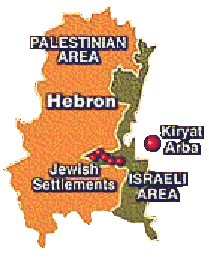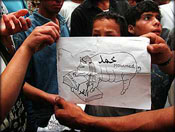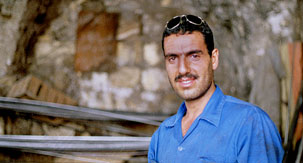
Travelling to a town with people who haven't been there - either at all or much - is always a good way of acquiring new perspectives. "There are so many settlements" around Jerusalem, remarked a PAS student called Samira, on the way there. Hebron is no different. It's always good to be refocused. I was disturbed anew last week by Israeli settlement policy in the Jerusalem Area, when I read a new primer produced by Hugh Humphries of Scottish Friends of Palestine, entitled In the beginning... Jerusalem:- Israeli or Palestinian owned? (How to occupy and dominate a city; a lay guide). I had been asked to review it for Middle East International, a London-based UK/US fortnightly publication that is worth getting your hands on if you want to track the developments in the Middle East, particularly here.
Adam Hanieh, another PAS student, had also come along. He has been helping to introduce us to the process of adding sound to the Birzeit website. He had been to Hebron a couple of times already and has been involved in solidarity work in Australia. Like Samira, he also drew my attention to something important this time by questioning me about an incident that happened in the afternoon. More about that later.
All of the shops in Hebron were closed because of yoam al-jumaa' (The Muslim holy day of Friday, lit. "the day of gathering"). Palestinian police and Israeli soldiers were sitting well apart and containing their respective constituencies in their own areas of responsibility, the result - as we found out - of some sort of agreement between the two sides. For their part, the Palestinian police would bring the Palestinian protesters back under control. No one seemed to know what the Israelis were going to do in exchange. Whatever the case, there is quiet in the town, although it is a tense and uncomfortable quiet.

The preceding week's clashes had followed the usual pattern, with the usually overwhelmingly Palestinian casualties interspersed with the usually occasional Israeli casualties, until a female settler had stuck up posters depicting the Prophet Mohammed as a pig with a pen in its hand, writing on a book labelled "The Quran" (pictured right, © AP). Needless to say, the next few days saw the ubiquitous stones and molotov cocktails were suddenly overtaken by pipe bombs and a young Israeli soldier, if I remember correctly, lost a leg. Israeli snipers and undercover units followed, until the current stand-off was finally reached.
Walking into the all but deserted Old City, through the No-Mans-Land between the troops of the two forces, we eventually reached a checkpoint where an Israeli soldier told us we could not proceed. After asking if it was alright to turn down another street, we made our way through the city to the al-Haram al-Ibrahimi Mosque, closed today to non-Muslims. Tomorrow, it will be closed to non-Jews, both closures a weekly routine supplimented by 9 additional days for the various festivals and feasts in each of the Muslim and Jewish calanders. This arrangement, implying a two-sided negotiation process that bears no relation to the actual reality, is the result of new arrangements after the Hebron Massacre, previously addressed in this diary.
With settler's buildings mixed throughout the Old City of Hebron, Samira asked, "how can you know which buildings are Palestinian and which are settlers?" Without the benefit of a mountain-top vantage point and the night that highlights the yellow glare of the sodium security lights of the settlers compunds and buildings, Adam and I compiled a checklist to help her answer this question:
Is the building covered with Israeli flags? This is a dead give away. Is the building surrounded by Israeli soldiers? This is also usually a reliable method. Is the building new-looking? Are there a proliferation of barriers of various kinds in the streets around the building? The more of these conditions that are satisfied, the more likely the building is to be a settler structure. Please note that only point one - the presence of multiple Israeli flags - is compulsory.

We talk with a blacksmith (pictured right), who welcomes Adam and Samira with hospitality when he finds out that they are returning Palestinians. He points to a settlement perched on the building above his shop while a soldier gazes down at us. He mutters that the situation is terrible these days, with no real differences since Oslo. He is called Abdul Salaam, which ironically translates as "slave of peace". We say goodbye and the screeches of a metal saw kick in again.